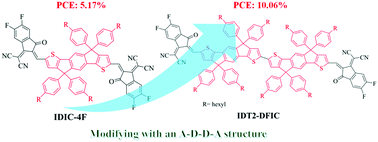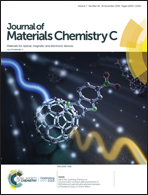An A–D–D–A-type non-fullerene small-molecule acceptor with strong near-infrared absorption for high performance polymer solar cells†
Abstract
An acceptor–donor–donor–acceptor (A–D–D–A)-type near-infrared non-fullerene small-molecule acceptor IDT2-DFIC with indacenodithiophene–indacenodithiophene (IDT2) as a donating core and 2-(5,6-difluoro-3-oxo-2,3-dihydro-1H-inden-1-ylidene)malononitrile (2FIC) as electron withdrawing end groups has been synthesized. Compared to A–D–A-type small-molecule acceptor IDIC-4F, IDT2-DFIC exhibits a low optical bandgap of 1.42 eV with strong absorption in the 450–874 nm region, and upshifted energy levels as an electron acceptor. Furthermore, the IDT2-DFIC-based devices exhibited higher and more balanced charge transport and smoother surface morphology. The power conversion efficiency (PCE) of the IDT2-DFIC-based devices is 10.06%, which is higher than that of the IDIC-4F-based devices (5.17%). Our work provides an efficient molecular design strategy to construct small molecule acceptors with near-infrared absorption.

- This article is part of the themed collection: Editor’s Choice: Organic Photovoltaics


 Please wait while we load your content...
Please wait while we load your content...